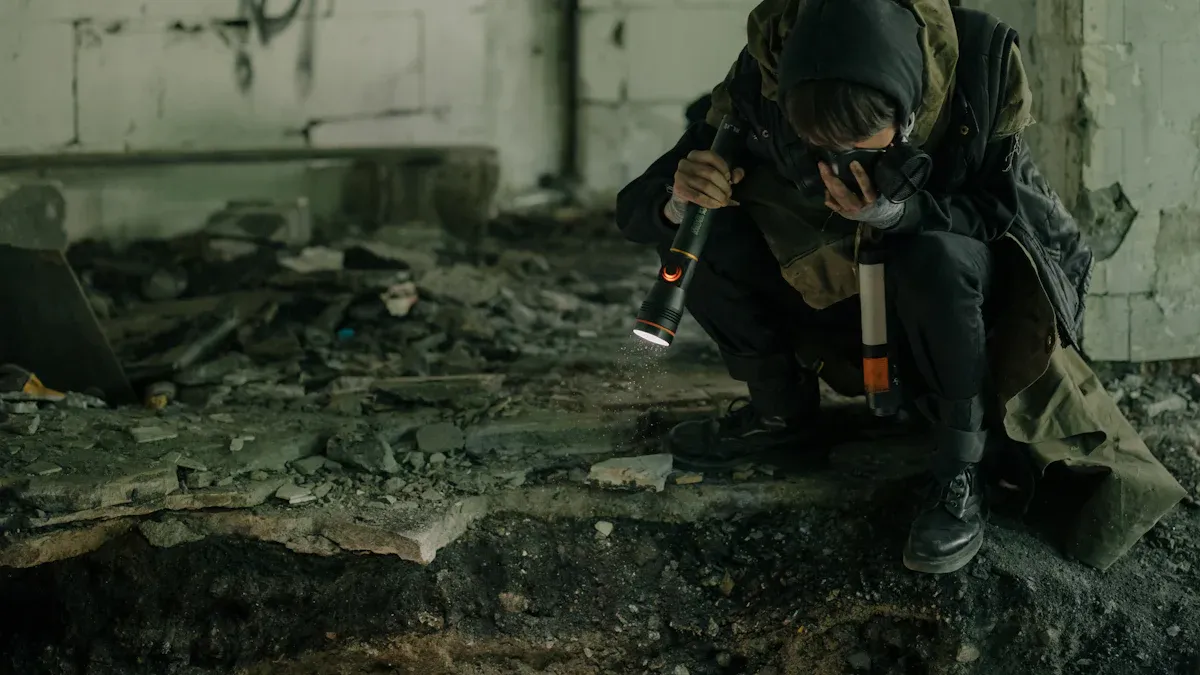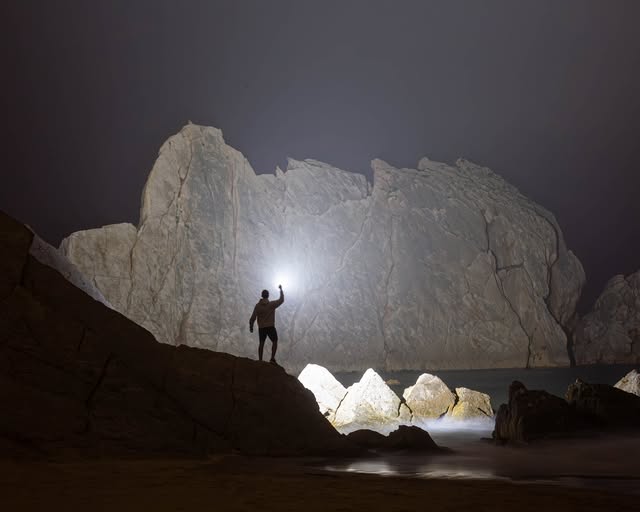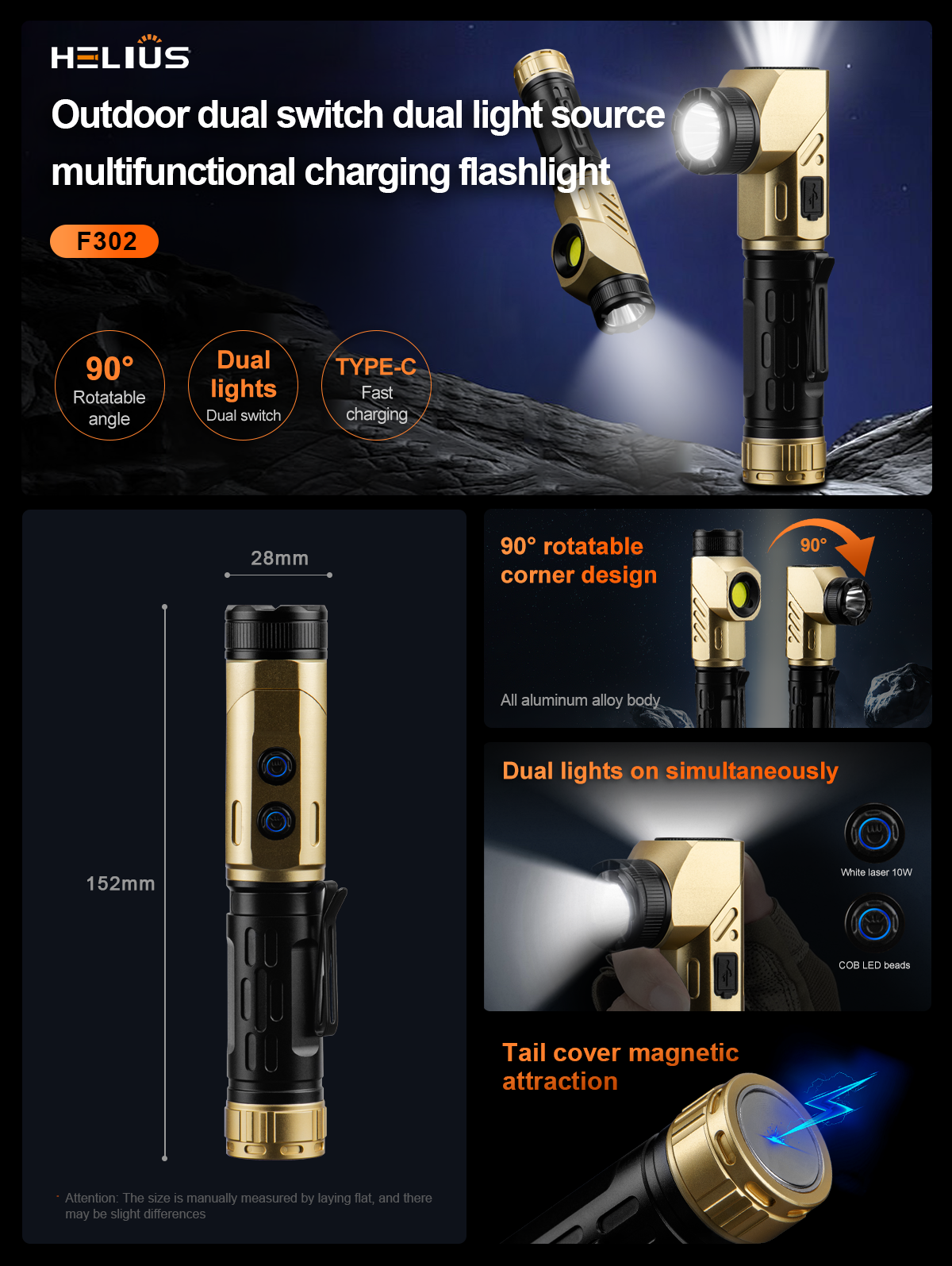Waterproof and Shockproof Flashlights: Essential for Emergency Situations

You count on waterproof flashlights during emergencies. These flashlights work well in wet or tough places. They also work in places where things can change fast. Search-and-rescue teams use them because they can trust them. People who like the outdoors pick them to stay safe.
Good tools help you get ready and feel sure in any situation.
Key Takeaways
Pick waterproof flashlights with high IP ratings like IPX6 or IPX7. These ratings help your flashlight work in heavy rain. They also help if it goes under water.
Choose shockproof flashlights made from strong materials like aircraft-grade aluminum. This helps your flashlight stay safe if you drop it. It also helps if it gets bumped during hard times.
Check your flashlight often and take care of it. Keep it in a cool, dry place. Test it many times. Change the batteries when needed. This makes sure it works when you really need it.
Waterproof Flashlights in Emergencies

Why Reliability Matters
You need a flashlight you can trust in emergencies. When things get scary, a good flashlight helps you stay calm. If the power goes out, emergency lighting helps you see. It makes you feel safe and less worried. Waterproof flashlights work even if it is wet or rough outside. They keep working when you need them the most.
If you check your emergency lights often, they will work when you need them. If you forget to check them, they might not work when you really need them.
A good flashlight can help save lives. For example, NIOSH shared a story about using the wrong flashlight. In 2001, two firefighters died in a silo explosion. The report said a non-intrinsically safe flashlight may have started the fire.
You should pick flashlights that work in tough places. Waterproof flashlights can handle water, mud, and drops. If a flashlight is not waterproof, it might stop working if it gets wet. This could leave you in the dark during an emergency.
Common Emergency Scenarios
There are many times when you need a waterproof flashlight. Some examples are:
Outdoor trips
Rainy days
Water sports
Getting ready for emergencies
Needing light in wet places
When there is bad weather, like hurricanes or floods, waterproof flashlights are very helpful. They keep working even if they get wet or go under water. For hurricanes, pick flashlights that are very bright (500-1,500 lumens) and have a strong IP rating. If your flashlight is tough and waterproof, it will work in hard times. This is important for getting through floods and blackouts.
Waterproof flashlights can help save lives. During Hurricane Katrina, a family used their flashlight to walk through water and ask for help. Their flashlight gave them hope. Good flashlights also help you feel safe when things are scary.
Waterproof flashlights work better than regular ones in emergencies. You can use them underwater or in rough places. They are good for caving, kayaking, or helping in wet emergencies. Regular flashlights might only work in light rain. They often stop working in heavy rain or if they get too wet.
Tip: Pick flashlights that last a long time and are very bright. Choose ones that are waterproof and shockproof. Fenix and Wuben are brands people trust in emergencies.
Key Features for Emergency Lighting

Waterproof Ratings
It is important to know waterproof ratings. These ratings tell you how much water a flashlight can handle. The IPX system is used to measure water resistance. Look at this table to compare the ratings:
Rating | Description |
|---|---|
IPX5 | Keeps out low-pressure water jets from any direction. |
IPX6 | Blocks high-pressure water jets from any direction. |
IPX7 | Stays waterproof when under 1 meter of water for 30 minutes. |
IPX8 | Can stay underwater up to a set depth, like 20 meters. |
Pick flashlights with IPX6 or IPX7 for emergencies. These ratings mean your flashlight will work in heavy rain or if it drops in water.
Shockproof Design
Shockproof flashlights keep working after drops or bumps. Makers use aircraft-grade aluminum and tactical polymer to make them strong. Some flashlights have rubber coatings for extra protection. These materials help flashlights survive falls from 1 meter or more. This is important when things get rough.
Battery and Power
Good batteries are important for emergency lighting. The best flashlights use batteries that work in hot or cold weather. Energizer Ultimate Lithium, NiCd, and Lithium Iron Phosphate batteries are good choices. These batteries last longer and do not leak. Your emergency lighting will be ready when you need it.
SOS and Modes
Different light modes help in emergencies. Strobe and SOS modes let you ask for help. Strobe mode flashes fast to get attention. SOS mode sends a distress signal everyone knows. Many flashlights also have high, low, and red flash modes for different needs.
Tip: Pick emergency lighting that is light and strong. It is easier to carry and works better in tough places.
Types of Waterproof Flashlights
Handheld
Handheld waterproof flashlights give you strong, focused light. They are small and fit in your hand or pocket. Makers use tough materials and seal them against water. You use these for quick jobs or to look in dark places. They also help you signal for help if needed. Many have modes that save battery power in emergencies. You can use them at home, on hikes, or when camping. Handheld flashlights are easy to carry and work well. They give you a good mix of power and ease.
Headlamps
Headlamps are good when you need your hands free. Straps hold the light on your head so it stays put. The beam moves with your eyes, so you see where you look. Some headlamps have red light to help you see at night. They are light and small, which is great for long trips. They are made to last and can take bumps and drops. Headlamps are great for hiking, caving, or fixing things in an emergency.
Lanterns
Lanterns light up a whole area around you. They shine in all directions so you can see everywhere. Some have hooks to hang them up or fold down to pack. You can change how bright they are for different needs. Lanterns are best for camping, blackouts, or group emergencies. They help everyone feel safe by making the space bright.
Tip: Look at what each type does before you pick one. Use this table to compare:
Flashlight Type | Design Features | Functionality |
|---|---|---|
Lanterns | 360-degree illumination, hanging hooks, collapsible designs | Lights entire spaces, multiple modes |
Headlamps | Hands-free, adjustable straps | Directs light where you look, red light modes |
Handheld | Impact-resistant, weather-sealed | Extreme conditions, bright focused light |
Choosing the Right Flashlight
Needs and Scenarios
Pick a flashlight that fits your needs. If you worry about power outages, choose one that lasts long. It should have a strong beam. For disaster response, you need a bright light. It should have modes you can change. In dangerous places, safety certifications are very important. Look at this table to see what you need for each situation:
Emergency Scenario | Example Flashlight Attributes | |
|---|---|---|
Disaster Response | High lumens, adjustable brightness for navigation and signaling | At least 1000 lumens |
Hazardous Environments | Intrinsically safe to prevent ignition risks | Low surface temperatures |
General Emergencies | Versatile features for various situations, including power outages and debris | Durable, water-resistant |
A flashlight is very important when weather is bad. You also need it if you must ask for help.
Budget Range
Flashlights come in many prices. Expensive ones are much brighter than cheap ones. They last longer and you do not replace them often. Here are some facts to help you pick:
Budget LED lights cost $50-$200.
Premium systems range from $200-$800.
Budget lights may need replacement 3-5 times during the life of one premium unit.
If you lose power often, buy a better flashlight. It saves money over time.
Trusted Brands
Pick brands with good safety certifications. These show the flashlight is safe for emergencies:
Certification | Description |
|---|---|
ATEX | Required for all electrical devices used in explosive atmospheres in Europe, ensuring compliance with European Directive 2014/34/EU. |
IECEx | A globally recognized certification for equipment used in explosive atmospheres, ensuring compliance with IEC 60079 safety regulations. |
Class I, Division 1 | Specifies equipment safe for areas where flammable gases are present continuously, mandated by OSHA, NFPA, and ANSI in the U.S. and Canada. |
Brands like Fenix, Wuben, and Streamlight have these certifications. You can trust them in emergencies.
Use and Maintenance Tips
Storage
Keep your flashlight in a cool, dry place. This helps stop water and heat from hurting it. Test your flashlight often to make sure it works. Put it in a case to protect it from drops. Label your flashlight so you can find it fast in an emergency. Add your flashlight to your emergency plans. If you see any problems, get a new one that works well.
Best Practices for Storage:
Keep it in a cool, dry spot.
Look at batteries for rust or leaks.
Wipe the lens with a soft cloth.
Test it often to check if it works.
Use a case to protect it.
Take care of charging ports if it recharges.
Label it so you can grab it fast.
Add it to your emergency plans.
Replace it if it does not work.
Tip: Storing your flashlight the right way means it will work when you need it.
Battery Care
Make your batteries last longer by following the maker’s rules. Put in and charge batteries the way the maker says. Change old batteries so they do not leak or lose power. Take batteries out if you are not using the flashlight. Store your flashlight in a cold, dry place to keep out water.
Follow the battery care rules.
Change batteries when needed.
Store it with no batteries inside.
Keep away from water and heat.
Cleaning
Clean your flashlight often to keep it working well. Use a soft, dry cloth to wipe the outside. Clean the lens with a microfiber cloth and lens cleaner. This stops scratches. Make sure seals are clean and use a little grease if it gets wet a lot. Take out the batteries and dry the flashlight if it gets wet. Do not use strong cleaners or heat to dry it.
Wipe the outside gently.
Clean the lens with the right cloth.
Use a little grease on seals.
Take out batteries and dry if wet.
Do not twist caps too tight.
Do not use strong cleaners or heat.
Note: Cleaning your flashlight often keeps it waterproof and shockproof. This helps it work well in emergencies.
You make things safer when you put a waterproof and shockproof flashlight in your emergency kit. Experts say long battery life, bright light, and strong build are the best features for safety. Always keep extra batteries in your emergency kit. Good lighting helps you feel safe, calm, and sure of yourself.
FAQ
How do you check if your flashlight is truly waterproof?
You can look for the IPX rating on the label. IPX7 or higher means your flashlight can handle water and wet conditions.
What is the best way to store your emergency flashlight?
You should keep your flashlight in a cool, dry place. Use a protective case and check the batteries every month.
Can you use rechargeable batteries in waterproof flashlights?
Yes, you can use rechargeable batteries. Make sure the battery type matches the flashlight’s instructions for safe and reliable use.
See Also
Selecting The Ideal Multi-Color Flashlight For Hunting And Emergencies
Enhance Outdoor Safety By Buying Mini Pocket Flashlights In Bulk
Finding The Best Flashlight Or Headlamp For Outdoor Activities
How To Find The Right Flashlight Supplier For Your Business
Advantages Of Buying Wholesale Flashlights For Diving Equipment
About US
Follow Us
Hello,Friend,
I am Mary from Helius, we are manufacturer of LED lighting products with more than a decade of experiences.
We offer hot selling products in market and guarantee the quality with competitive cost.
Let’s have more discussion on your inquiry.
Or you can reach out me via what’s up/tele gram +8618123952945 if it’s favorable to you.
Address
4th Floor, Building A16, Intelligent terminal industrial park of Silicon Valley, Dafu Industrial Zone,Guanlan, Shenzhen, 518110 China
Contacts
mary@heliuslights.com
heliuslight04@hotmail.com
+0086 18123952945
